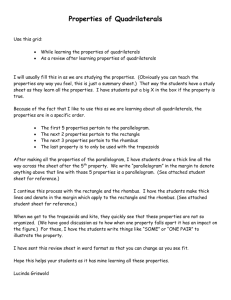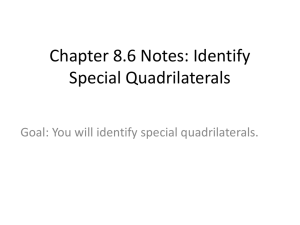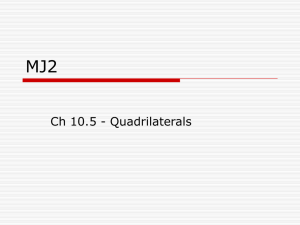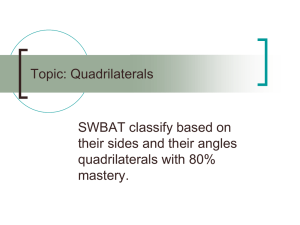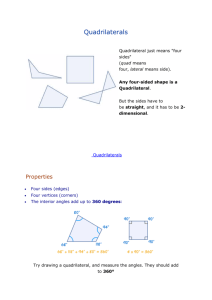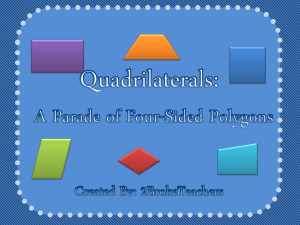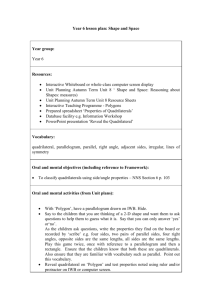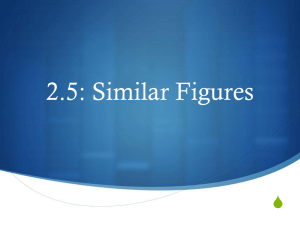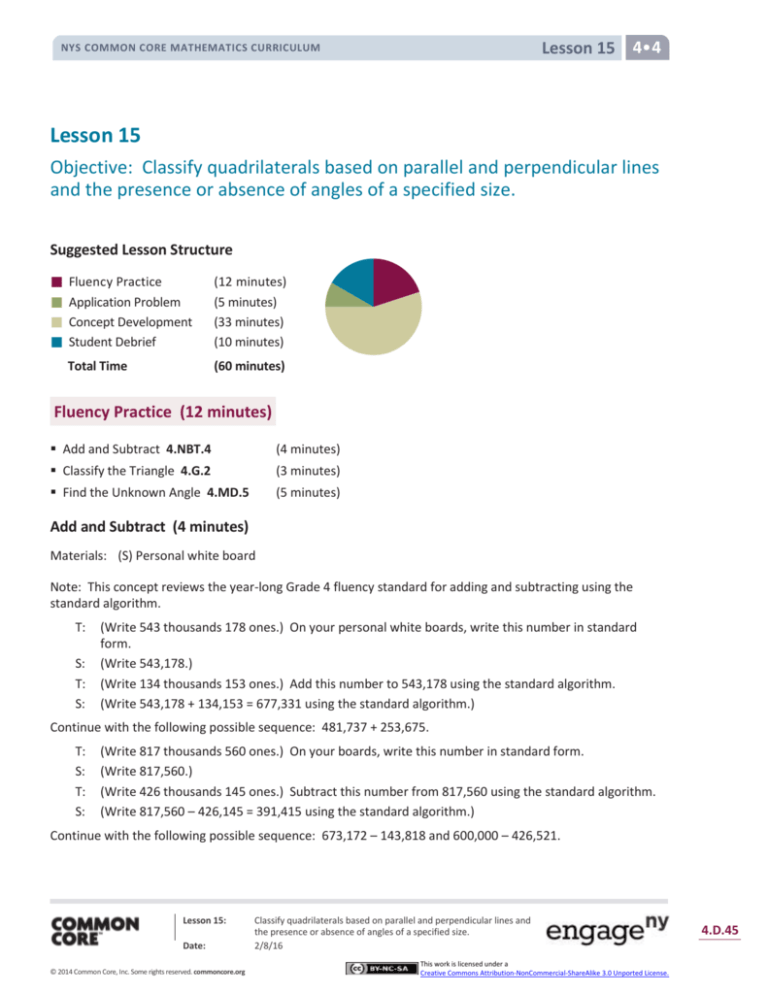
Lesson 15 4 4
NYS COMMON CORE MATHEMATICS CURRICULUM
Lesson 15
Objective: Classify quadrilaterals based on parallel and perpendicular lines
and the presence or absence of angles of a specified size.
Suggested Lesson Structure
Fluency Practice
Application Problem
Concept Development
Student Debrief
Total Time
(12 minutes)
(5 minutes)
(33 minutes)
(10 minutes)
(60 minutes)
Fluency Practice (12 minutes)
Add and Subtract 4.NBT.4
(4 minutes)
Classify the Triangle 4.G.2
(3 minutes)
Find the Unknown Angle 4.MD.5
(5 minutes)
Add and Subtract (4 minutes)
Materials: (S) Personal white board
Note: This concept reviews the year-long Grade 4 fluency standard for adding and subtracting using the
standard algorithm.
T:
S:
T:
S:
(Write 543 thousands 178 ones.) On your personal white boards, write this number in standard
form.
(Write 543,178.)
(Write 134 thousands 153 ones.) Add this number to 543,178 using the standard algorithm.
(Write 543,178 + 134,153 = 677,331 using the standard algorithm.)
Continue with the following possible sequence: 481,737 + 253,675.
T:
S:
T:
S:
(Write 817 thousands 560 ones.) On your boards, write this number in standard form.
(Write 817,560.)
(Write 426 thousands 145 ones.) Subtract this number from 817,560 using the standard algorithm.
(Write 817,560 – 426,145 = 391,415 using the standard algorithm.)
Continue with the following possible sequence: 673,172 – 143,818 and 600,000 – 426,521.
Lesson 15:
Date:
© 2014 Common Core, Inc. Some rights reserved. commoncore.org
Classify quadrilaterals based on parallel and perpendicular lines and
the presence or absence of angles of a specified size.
2/8/16
This work is licensed under a
Creative Commons Attribution-NonCommercial-ShareAlike 3.0 Unported License.
4.D.45
Lesson 15 4 4
NYS COMMON CORE MATHEMATICS CURRICULUM
Classify the Triangle (3 minutes)
Note: This fluency activity reviews Lesson 13.
T:
S:
T:
S:
T:
S:
T:
S:
T:
S:
T:
S:
T:
S:
T:
S:
T:
S:
(Project triangle.) Is the triangle equilateral, scalene, or
isosceles?
Equilateral.
Why?
Because all the sides are the same length.
Is it acute, right, or obtuse?
Acute.
Why?
Because all the angles are less than 90°.
(Project triangle.) Say the measure of the largest angle.
130°.
Is the triangle equilateral, scalene, or isosceles?
Scalene.
Why?
Because all the sides are different.
Is the triangle acute, right, or obtuse?
Obtuse.
Why?
Because it has an angle greater than 90°.
Continue the process for the other triangles.
Find the Unknown Angle (5 minutes)
Materials: (S) Personal white board
Note: This fluency exercise reviews Lesson 10.
T:
S:
(Project the first unknown angle problem. Run a
finger over the largest angle.) This is a right angle.
On your personal white boards, write a number
sentence to find the measure of ∠𝑥.
(Write 90 – 50 = 𝑥. Below it, write 𝑥 ° = 40°.)
Continue with the remaining unknown angle problems.
Lesson 15:
Date:
© 2014 Common Core, Inc. Some rights reserved. commoncore.org
Classify quadrilaterals based on parallel and perpendicular lines and
the presence or absence of angles of a specified size.
2/8/16
This work is licensed under a
Creative Commons Attribution-NonCommercial-ShareAlike 3.0 Unported License.
4.D.46
Lesson 15 4 4
NYS COMMON CORE MATHEMATICS CURRICULUM
Application Problem (5 minutes)
Materials: (S) Square grid paper
a. On grid paper, draw two perpendicular line segments, each measuring 4 units, which extend from a
̅̅̅̅ and 𝑈𝑉
̅̅̅̅. What shape did you construct? Classify it.
̅̅̅̅. Draw 𝑆𝑈
point 𝑉. Identify the segments as 𝑆𝑉
̅̅̅̅ is a line of symmetry. Construct the other half of the figure. What figure did you
b. Imagine 𝑆𝑈
construct? How can you tell?
Note: This Application Problem reviews segments and points
from Lesson 1, perpendicular lines from Lesson 3, lines of
symmetry from Lesson 12, classifying triangles from Lesson 13,
and constructing triangles from Lesson 14. It also links
knowledge of the attributes of a square from previous grades,
bridging to this lesson’s objective of classifying quadrilaterals.
NOTES ON
MULTIPLE MEANS
OF ACTION AND
EXPRESSION:
Provide alternatives to constructing
polygons with pencil and paper to
students working below grade level
and others. For example, tactile
learners may use geoboards, while
others may benefit from using a virtual
geoboard such as that found at the
following link (which can be enlarged
and made tactile using an interactive
white board):
http://www.mathplayground.com
/geoboard.html
Alternatively, provide grid paper to
ease the task of drawing.
Lesson 15:
Date:
© 2014 Common Core, Inc. Some rights reserved. commoncore.org
Classify quadrilaterals based on parallel and perpendicular lines and
the presence or absence of angles of a specified size.
2/8/16
This work is licensed under a
Creative Commons Attribution-NonCommercial-ShareAlike 3.0 Unported License.
4.D.47
Lesson 15 4 4
NYS COMMON CORE MATHEMATICS CURRICULUM
Concept Development (33 minutes)
Materials: (T/S) Problem Set, ruler, right angle template (built from Lesson 2 Template)
Problem 1: Construct and define trapezoids.
T:
S:
T:
MP.5
What do you know about quadrilaterals?
They have four straight sides. They can be shapes, like a square or a rectangle.
Use Problem 1 on your Problem Set to construct a quadrilateral with at least one set of parallel sides.
(Guide students through the process of drawing the quadrilateral.)
Step 1.
Draw a straight, horizontal segment.
Step 2.
Use your right angle template and ruler to draw a segment parallel to that segment.
Step 3.
Draw a third segment that crosses both.
Step 4.
Draw a fourth different segment that crosses both, but does not cross the third
segment.
Steps 1 and 2
T:
S:
T:
Step 4
Step 3
Compare your quadrilateral with those of your group,
looking at angle size and side length.
The sides of mine are all different lengths. Mine has
two obtuse angles and two acute angles. Mine looks
more like a rectangle. Mine has two right angles, an
acute angle, and an obtuse angle. Mine has angles of
different sizes. One set of opposite sides look equal.
Yes, but we all have shapes with one set of parallel
sides.
All of our quadrilaterals have at least one set of parallel
sides, which means all of our quadrilaterals are
trapezoids. However, some of your trapezoids might
have other familiar names, like rectangle.
Other possible trapezoids
Be sure that the students identify the pair of parallel sides in a square, rectangle, non-rectilinear
parallelogram, and rhombus.
Lesson 15:
Date:
© 2014 Common Core, Inc. Some rights reserved. commoncore.org
Classify quadrilaterals based on parallel and perpendicular lines and
the presence or absence of angles of a specified size.
2/8/16
This work is licensed under a
Creative Commons Attribution-NonCommercial-ShareAlike 3.0 Unported License.
4.D.48
Lesson 15 4 4
NYS COMMON CORE MATHEMATICS CURRICULUM
T:
Construct two more trapezoids for Problem 1. Ask your partners for suggestions on how they
constructed their trapezoids as you construct a new one.
Allow time for students to construct two more trapezoids.
Problem 2: Construct and define parallelograms.
T:
Under Problem 2, let’s construct a quadrilateral with two sets of parallel sides. Start by drawing one
set of parallel segments, the same way you did in Problem 1. (Guide students through the process of
drawing the quadrilateral.)
1. Draw a straight, horizontal segment.
2. Use your right angle template and ruler to draw a segment parallel to that segment.
3. Draw a third segment that crosses both.
4. Using your ruler and right angle template, draw a fourth different segment that crosses the
first two segments and that is parallel to the third segment.
Steps 1 and 2
T:
Step 4
Step 3
Verify both sets of lines are parallel. Compare your
quadrilateral with those of your group.
Students discuss similar and contrasting features of their figures.
T:
S:
T:
T:
Are all of these shapes drawn in Problem 2 trapezoids?
They don’t look like the trapezoid I drew. Yeah, this one
looks like mine from Problem 1. A trapezoid has to have
at least one set of parallel sides. Mine has two! So these
must be trapezoids since they all have at least one pair of
parallel sides.
All of the trapezoids we constructed for Problem 2 have two
sets of parallel sides. We call quadrilaterals with two pairs of
parallel sides parallelograms. Again, I see some figures that I
might give another name to, but all of the shapes we’ve
constructed are parallelograms. Record the word
parallelogram for Problem 2. Construct two more
parallelograms for Problem 2. Ask your partners for suggestions on
how they constructed their parallelograms, or construct a new one.
Did anyone draw the same quadrilateral in Problems 1 and 2?
Lesson 15:
Date:
© 2014 Common Core, Inc. Some rights reserved. commoncore.org
Other possible parallelograms
Classify quadrilaterals based on parallel and perpendicular lines and
the presence or absence of angles of a specified size.
2/8/16
This work is licensed under a
Creative Commons Attribution-NonCommercial-ShareAlike 3.0 Unported License.
4.D.49
Lesson 15 4 4
NYS COMMON CORE MATHEMATICS CURRICULUM
S:
T:
Yes, I drew a parallelogram in Problem 1. So, a parallelogram has two names?
A trapezoid must have at least one set of parallel sides. A parallelogram is a special trapezoid. It has
two sets of parallel sides. To be specific, we call the quadrilaterals in Problem 2 parallelograms.
Problem 3: Construct and define rectangles.
T:
S:
T:
For Problem 3, we need to make a parallelogram with four right angles. What do we call two lines
that intersect at a right angle?
Perpendicular lines.
(Guide students through the process of drawing the parallelogram.)
Step 1.
Draw a straight, horizontal segment.
Step 2.
Use your right angle template and ruler to draw a segment parallel to that segment.
Step 3.
Draw a third segment with a right angle, perpendicular to the base line.
Step 4.
Draw a fourth segment that is also perpendicular to the first segment.
Steps 1,2, and 3
T:
S:
T:
T:
Step 4
Compare your quadrilateral with those of your group,
looking at angle measure and side length.
The fourth segment is parallel to the third one.
It has two sets of parallel sides. That means
it is a parallelogram. Mine has four right
angles. The opposite sides are the same
length. It looks like a rectangle. Mine
looks like a square.
These quadrilaterals all have two sets of
parallel sides, so they are parallelograms and
trapezoids. However, our figures have another
special attribute—four right angles, so they are
also rectangles.
Construct two more rectangles for Problem 3. (A square is a special rectangle, so at least one should
be evidenced in the examples.)
Lesson 15:
Date:
© 2014 Common Core, Inc. Some rights reserved. commoncore.org
Classify quadrilaterals based on parallel and perpendicular lines and
the presence or absence of angles of a specified size.
2/8/16
This work is licensed under a
Creative Commons Attribution-NonCommercial-ShareAlike 3.0 Unported License.
4.D.50
Lesson 15 4 4
NYS COMMON CORE MATHEMATICS CURRICULUM
Problem 4: Construct and define squares.
T:
Problem 4 requires us to draw a rectangle with sides
that are all the same length. Discuss with your group
how you might do that.
S: Draw each side the same length. We can draw the
parallel sides, then one of the perpendicular sides.
Then, we will have to measure some sides.
T: (Guide students through the process of drawing the
rectangle.)
1. Draw a straight, horizontal segment.
2. Use your right angle template and ruler to draw a
segment parallel to that segment.
3. Draw a third segment with a right angle,
perpendicular to the base line.
4. Measure the length of the third side, and mark the
same length on both of the first segments. Start the
measurement at the third side.
5. Draw a fourth segment perpendicular to the first
segment through those marks.
Steps 1, 2, and 3
S:
T:
S:
NOTES ON
MULTIPLE MEANS
OF REPRESENTATION:
Support math language acquisition for
English language learners and others.
Post on the word wall, and have
students add to their personal math
dictionaries quadrilateral,
parallelogram, and trapezoid and
corresponding pictures. Guide student
connections amongst the quadrilaterals
using graphic organizers, such as a
Venn diagram. Teach the etymology or
meaningful word parts, if helpful. Offer
or facilitate student-made mnemonic
devices. Challenge students working
above grade level to research
connections between similar words,
such as trapeze and trapezoid, and
quarter and quadrilateral.
Step 4
Step 5
We made a square!
Yes, a square is a special rectangle and has all sides the same length. Construct two more squares.
If a square is a rectangle, then a square can also be a parallelogram. And a trapezoid!
Lesson 15:
Date:
© 2014 Common Core, Inc. Some rights reserved. commoncore.org
Classify quadrilaterals based on parallel and perpendicular lines and
the presence or absence of angles of a specified size.
2/8/16
This work is licensed under a
Creative Commons Attribution-NonCommercial-ShareAlike 3.0 Unported License.
4.D.51
Lesson 15 4 4
NYS COMMON CORE MATHEMATICS CURRICULUM
Problem Set (10 minutes)
Students should do their personal best to complete the
Problem Set within the allotted 10 minutes. For some
classes, it may be appropriate to modify the assignment by
specifying which problems they work on first. Some
problems do not specify a method for solving. Students
solve these problems using the RDW approach used for
Application Problems.
Student Debrief (10 minutes)
Lesson Objective: Classify quadrilaterals based on parallel
and perpendicular lines and the presence or absence of
angles of a specified size.
The Student Debrief is intended to invite reflection and
active processing of the total lesson experience.
Invite students to review their solutions for the Problem
Set. They should check work by comparing answers with a
partner before going over answers as a class. Look for
misconceptions or misunderstandings that can be
addressed in the Debrief. Guide students in a conversation
to debrief the Problem Set and process the lesson.
You may choose to use any combination of the questions
below to lead the discussion.
For Problem 6, what makes a square different
from a rectangle? Why is it important to define a
square as a rectangle with four equal length sides
and not as a quadrilateral with four equal length
sides?
What are some attributes that every square has
in common? How is a square a special case of a
rectangle, a parallelogram, and a trapezoid?
If your teacher asked you to draw a trapezoid,
and you drew a parallelogram, explain to your
teacher why a parallelogram is also a trapezoid.
Can a trapezoid be defined as a square? What
attributes of a square are not present in a
trapezoid? Why does it only work in the reverse:
a square is also a trapezoid? What attributes of a
trapezoid are present in a square?
We have seen today that a figure can belong to different categories. That is often true in life. For
Lesson 15:
Date:
© 2014 Common Core, Inc. Some rights reserved. commoncore.org
Classify quadrilaterals based on parallel and perpendicular lines and
the presence or absence of angles of a specified size.
2/8/16
This work is licensed under a
Creative Commons Attribution-NonCommercial-ShareAlike 3.0 Unported License.
4.D.52
Lesson 15 4 4
NYS COMMON CORE MATHEMATICS CURRICULUM
example, consider the following words: woman, mother, sister, and aunt. A woman can be a
mother, but only is a mother if she has children. A woman isn’t a sister unless she has a sister or a
brother. Each classification has a defining attribute. A mother, sister, and aunt are all women just as
a parallelogram, rectangle, and square are all trapezoids and, ultimately, all quadrilaterals. Talk to
your partner about the following set of words: clothes, pants, and jeans.
Exit Ticket (3 minutes)
After the Student Debrief, instruct students to complete the Exit Ticket. A review of their work will help you
assess the students’ understanding of the concepts that were presented in the lesson today and plan more
effectively for future lessons. You may read the questions aloud to the students.
Lesson 15:
Date:
© 2014 Common Core, Inc. Some rights reserved. commoncore.org
Classify quadrilaterals based on parallel and perpendicular lines and
the presence or absence of angles of a specified size.
2/8/16
This work is licensed under a
Creative Commons Attribution-NonCommercial-ShareAlike 3.0 Unported License.
4.D.53
NYS COMMON CORE MATHEMATICS CURRICULUM
Name
Lesson 15 Problem Set 4 4
Date
Construct the figures with the given attributes. Name the shape you created. Be as specific as possible. Use
extra blank paper as needed.
1. Construct quadrilaterals with at least one set of parallel sides.
2. Construct a quadrilateral with two sets of parallel sides.
3. Construct a parallelogram with four right angles.
4. Construct a rectangle with all sides the same length.
Lesson 15:
Date:
© 2014 Common Core, Inc. Some rights reserved. commoncore.org
Classify quadrilaterals based on parallel and perpendicular lines and
the presence or absence of angles of a specified size.
2/8/16
This work is licensed under a
Creative Commons Attribution-NonCommercial-ShareAlike 3.0 Unported License.
4.D.54
Lesson 15 Problem Set 4 4
NYS COMMON CORE MATHEMATICS CURRICULUM
5. Use the word bank to name each shape, being as specific as possible.
Parallelogram
Trapezoid
a.
Rectangle
Square
b.
___________________
c.
___________________
d.
___________________
___________________
6. Explain the attribute that makes a square a special rectangle.
7. Explain the attribute that makes a rectangle a special parallelogram.
8. Explain the attribute that makes a parallelogram a special trapezoid.
Lesson 15:
Date:
© 2014 Common Core, Inc. Some rights reserved. commoncore.org
Classify quadrilaterals based on parallel and perpendicular lines and
the presence or absence of angles of a specified size.
2/8/16
This work is licensed under a
Creative Commons Attribution-NonCommercial-ShareAlike 3.0 Unported License.
4.D.55
NYS COMMON CORE MATHEMATICS CURRICULUM
Name
Lesson 15 Exit Ticket 4 4
Date
1. In the space below, draw a parallelogram.
2. Explain why a rectangle is a special parallelogram.
Lesson 15:
Date:
© 2014 Common Core, Inc. Some rights reserved. commoncore.org
Classify quadrilaterals based on parallel and perpendicular lines and
the presence or absence of angles of a specified size.
2/8/16
This work is licensed under a
Creative Commons Attribution-NonCommercial-ShareAlike 3.0 Unported License.
4.D.56
Lesson 15 Homework 4 4
NYS COMMON CORE MATHEMATICS CURRICULUM
Name
Date
1. Use the word bank to name each shape, being as specific as possible.
Parallelogram
Trapezoid
a.
Rectangle
Square
b.
___________________
c.
___________________
d.
___________________
___________________
2. Explain the attribute that makes a square a special rectangle.
3. Explain the attribute that makes a rectangle a special parallelogram.
4. Explain the attribute that makes a parallelogram a special trapezoid.
Lesson 15:
Date:
© 2014 Common Core, Inc. Some rights reserved. commoncore.org
Classify quadrilaterals based on parallel and perpendicular lines and
the presence or absence of angles of a specified size.
2/8/16
This work is licensed under a
Creative Commons Attribution-NonCommercial-ShareAlike 3.0 Unported License.
4.D.57
NYS COMMON CORE MATHEMATICS CURRICULUM
Lesson 15 Homework 4 4
5. Construct the following figures based on the given attributes. Give a name to each figure you construct.
Be as specific as possible.
a. A quadrilateral with four sides the same
length and four right angles.
b. A quadrilateral with two sets of parallel
sides.
c. A trapezoid with only one set of parallel
sides.
d. A parallelogram with four right angles.
Lesson 15:
Date:
© 2014 Common Core, Inc. Some rights reserved. commoncore.org
Classify quadrilaterals based on parallel and perpendicular lines and
the presence or absence of angles of a specified size.
2/8/16
This work is licensed under a
Creative Commons Attribution-NonCommercial-ShareAlike 3.0 Unported License.
4.D.58

